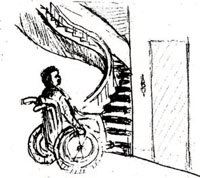Non-Communicable Diseases, Emergency Care and Mental Health Module: 19. Disability and Community Rehabilitation
Study Session 19 Disability and Community Rehabilitation
Introduction
In recent years, more and more health professionals have started to distinguish impairment from disability. Impairment refers to the physical, intellectual, mental and/or sensory characteristics or conditions that limit a person’s individual or social functioning, in comparison with someone without these impairments.
Disability, in contrast, is not something individuals ‘have’, but has a wider social meaning. It is the exclusion of people with impairments due to attitudinal and environmental barriers that limits their full and equal participation in the life of the community and society at large (Figure 19.1). It is now accepted that the disabling environmental and social barriers are major causes of the disability experienced by individuals with impairments.

It is important to ensure the inclusion of disabled people in society. Inclusion refers to the need to make sure that people with disabilities have access to all necessary services and that the barriers and limitations they experience in society are reduced. In this study session you will learn about disability and impairment, and ways to support the inclusion and rehabilitation of people with impairments in your community.
